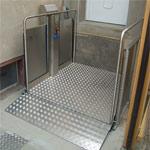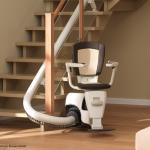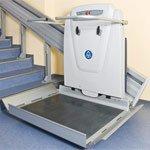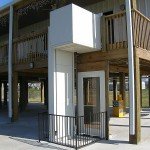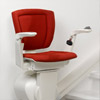The installation of a stairlift can become a sheer challenge for untrained persons. Only trained installers can “guarantee” the safety and functionality of a stairlift after installation and take responsibility in case of damage. When is the self-installation of a lift worthwhile and what cost savings can be expected?
Does the warranty period for stairlifts also apply if you install it yourself? What safety regulations must be observed? Must the building authority be informed if you install an outdoor lift? If you want to install a stair lift yourself, many questions must be clarified in advance. After all, self-installation of a lift does not always lead to cost savings in the long run. We give in the following article an overview for opportunities and risks.
Preliminary: Which stairlift is the right one?
Since the installation costs for a new stairlift can quickly get out of hand, you should be clear in advance where the lift is to be installed and what requirements it must meet. Since there are currently many different suppliers and models on the market, it is recommended to make a preselection as early as possible. In addition, you should in any case get several quotations to be able to better compare prices.
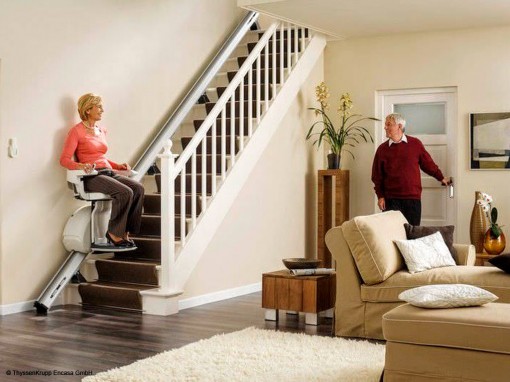 PhotosSource: tkelevator.com | © ThyssenKrupp AG
PhotosSource: tkelevator.com | © ThyssenKrupp AGThe consumer protection agency also recommends that people test the stair lift thoroughly before buying it. For many people, using such a lift takes a lot of getting used to at first, so it’s important to determine in advance whether you can get along with the model you want. You should also get an overview of the possible additional equipment. Since one normally makes such a purchase only once, the stairlift should be perfectly tailored to your needs from the outset.
What must be considered before installation?
First of all, it is necessary to find the right model. Currently, one has the choice between a seat lift, platform lift, lifting platform or stand-up lift. Furthermore, one should consider whether one wants to get a new model or whether a used stairlift is also available. With used models one should make sure that these have the suitable dimensions and over the desired equipment. Many manufacturers offer, in addition to the purchase, also the possibility to rent the stairlift or to pay off by a financing. In addition, you should inform yourself about the funding opportunities. In addition to KfW funding, most health insurance companies also offer subsidies.
The basic steps in the installation
First, the staircase is covered with foil, so that it is not too dirty. After that, the laying of the rails begins. These are mounted, depending on the circumstances, either on the inside of the stairs or on the wall. Accordingly, you should make sure that pictures or the like are suspended, so that the necessary drilling can be done without further problems. The rail system is then adapted to the course of the stairs. In the case of particularly curved or steep stairs, you need to pay special attention to the fact that all the rails are dug at the same height.
 Source: ascendor.at | Press image
Source: ascendor.at | Press imageBy contrast, a platform lift, which allows a wheelchair to be transported, requires two rails to better support and distribute the additional weight. However, the stairwell for this must be large enough that you can also walk next to the lift. Of course, if the staircase is particularly steep or curvy, installation can take significantly longer. After the rails are laid, the stairlift is hooked into the so-called linkage. After that, the position of the lift is corrected until it can be used absolutely smoothly.
Installation on one’s own responsibility or assembly by professionals?
The installation of a stair lift or Stairlift can quickly become an almost insurmountable task for laymen. In order to be able to guarantee the security and the functional efficiency, one should let the assembly therefore best of trained specialists accomplish. They are trained to professionally install the rail system of the stairlift even over several floors or on particularly curved or steep stairs. In addition, the fitters are also familiar with the legally prescribed installation regulations.
It is advisable to grant the fitters access to the respective premises before the installation of the stairlift. This allows the installation team to get a precise picture of the local conditions, which can significantly simplify the subsequent installation. The actual installation of the stairlift takes on average between three and eight hours. Afterwards, the lift is subjected to another detailed safety and quality inspection. Here, by the way, you should not be afraid to ask open questions directly.
The installation of a normal seat lift for a person without a wheelchair
If you decide to install the stairlift on your own, you should make sure in advance that you deposit all the necessary materials in one place. Since you only need one rail run for a seat lift, you can already position the rails in advance in the correct order on the stairs. This provides a much better overview during the subsequent installation process.
After the rails have been installed and an uninterrupted power supply has been ensured, the seat lift must be carefully attached to the linkage. This usually requires at least two people. Then the position of the lift must be adjusted until it can travel the specified distance without jerking. After each adjustment, the person concerned should make a test run to ensure that the readjustment was also correct. Depending on the length and effort involved, installation of a seat lift takes between five and ten hours.
Installation of a platform lift for wheelchair users
The normal stair lift (or seat lift) is not suitable for use with a wheelchair due to its design. For this reason, wheelchair users need a so-called platform lift. This enables the transport of the affected person together with the wheelchair. However, these platform lifts require significantly more space in the stairwell. So, in the case of particularly narrow and curvy staircases, it may be possible to install the platform lift only if you make structural changes.
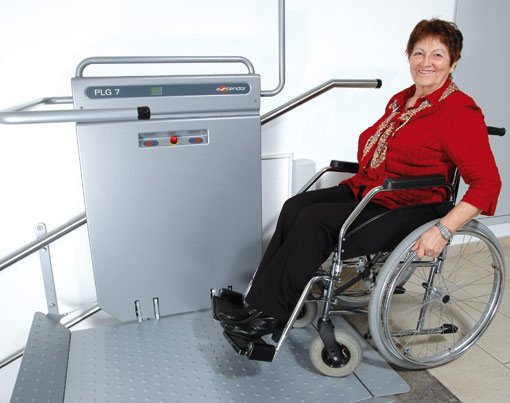 PhotosSource: ascendor.at | Press image
PhotosSource: ascendor.at | Press imageWhen extending the staircase, it is necessary to comply with the building regulations – which, by the way, also applies to the owners of a home. Due to the significantly higher weight, a platform lift requires two rails. During installation, it is important to ensure that these pipe systems are anchored stably in the wall. In addition, the power supply must be guaranteed at each stop. So, for example, if the platform lift is to run over two floors, the power supply must not be interrupted.
Stairlift installation in the home
Who wants to install a stairlift in his condominium or in his own house, must in any case comply with the building regulations in force in the respective state. For this reason, it is best to find out in advance about the currently applicable law. In addition, you can also get more information about what you need to consider during installation and which structural changes are possible at all.
As soon as the preparations have been completed, the installation can take place. A normal seat lift requires only one rail, which is mounted either on the inside of the stairs or on the wall. In any case, the rail construction must be adapted exactly to the course of the stairs. Here it is important to ensure that the rail is firmly anchored so that it can bear the weight of the stairlift and the person concerned. Therefore, it is recommended to consult a structural engineer before installation.
Installation of a stairlift in an apartment building
If the stairlift is to be installed in a multi-family house, of course the legal requirements also apply. According to the fire safety regulations, the escape route via the stairwell must never be restricted. This means that when installing the seat lift, you have to make sure that at least one person can walk next to the lift. When installing a stair lift in multi-story buildings, you must make sure that the power supply is never interrupted along the entire route.
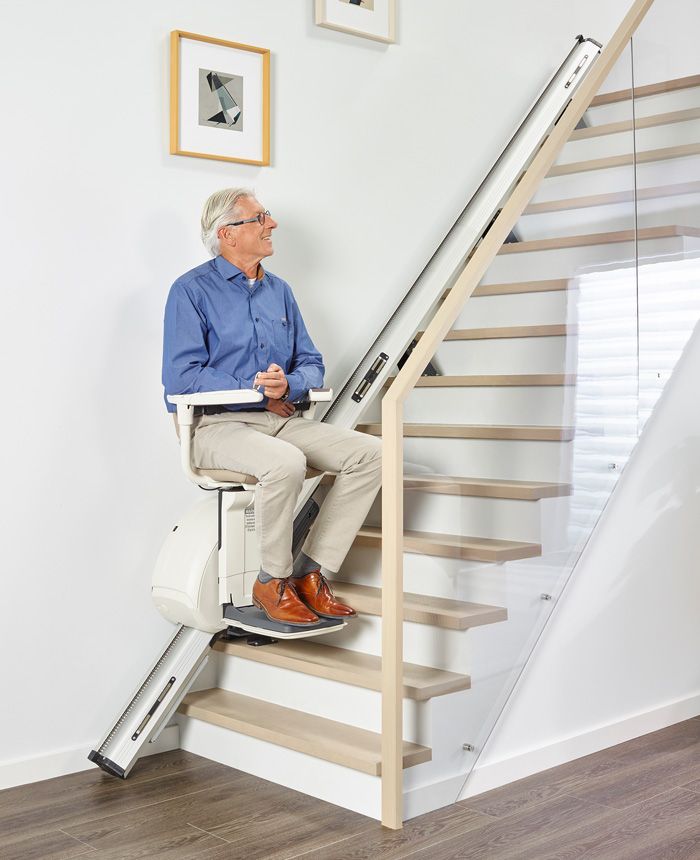 Photo: © Thyssenkrupp AG
Photo: © Thyssenkrupp AGIf you install the stairlift in a multi-family house, you will of course need a correspondingly large number of rails. Therefore, it is advisable to distribute the rails before installation in the same way as they will be installed later. The same applies to the screws and other tools. Another condition for the installation of the seat lift: it is not allowed to use flammable materials. So this point should be considered already when choosing the working material.
Stairlift installation as a tenant
According to the German Tenant Protection Association, a landlord may not prohibit the installation of a stair lift under any circumstances. However, you must be able to prove that you are definitely dependent on such a stair lift for physical reasons. The costs for the stair lift and for the installation, as well as possible structural changes, must be borne completely by the person concerned. In addition, you should consult with the landlord beforehand, as he may require an additional deposit after the installation.
Likewise, one must ensure during installation that the other tenants have unrestricted access to the stairwell at all times. For this reason, the materials should not simply be left lying around, but should, if possible, only be brought to the installation site when they can be installed immediately afterwards. Since it is a tenement house, one should do without unnecessary drilling during the assembly and also cleanly plaster and paint the walls afterwards.
Important: the safety
For the installation of stairlifts applies, on the one hand, the Equipment and Product Safety Act and, on the other hand, the so-called Machinery Ordinance. In addition, a stairlift must be able to show the usual seals. In addition to the TÜV approval for a lifting height of more than three meters, the EC declaration of conformity applies for lower lifting heights. Furthermore, one should pay attention to the type plate and the serial number of the lift. In addition to the safety approval, the year of manufacture must also be noted here.
In addition, there are some regulations related to safety, installation and fire protection. Therefore, the stair lift must always be installed in such a way that the staircase continues to be suitable as an escape route. If this function of the staircase is limited after installation, you have to expect that the entire structure will have to be rebuilt. However, it is possible to set up so-called waiting zones in case the staircase cannot be used in parallel by pedestrians. In order to be able to guarantee the safety of the stairlift in the future, it is advisable to conclude a maintenance contract with the respective manufacturer. Normally, the stairlift will be inspected and tested once a year.



